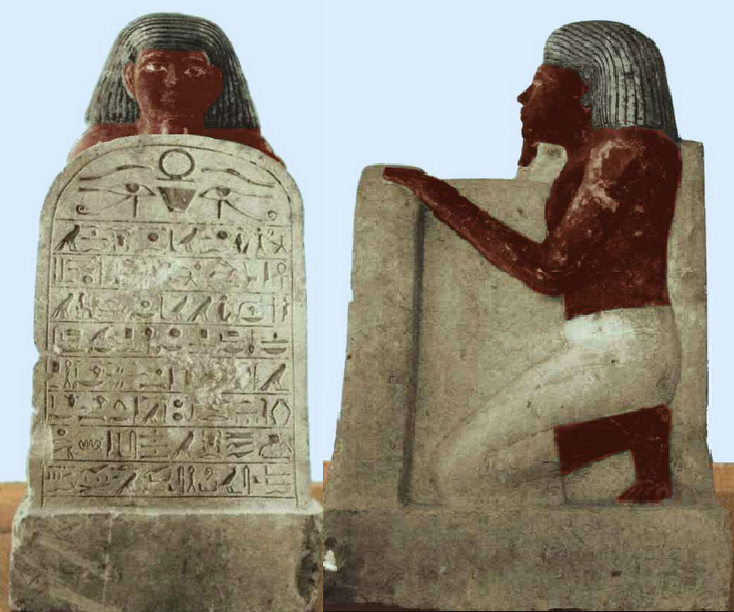‘The Awakening Aten’ is a novel based on the fictional lives of real people living in Egypt 3,500 years ago.
One of those people is Nahkt.
There is no information about Nahkt other than that contained in his tomb. His name means ‘strong.’ In his lifetime he held the titles of “scribe” and “serving priest”. The only other information we can glean is that his wife was named, Tawy, she was a ‘chantress of Amun’, and that her son was called Amenemapet.
Nahkt’s tomb was discovered (and probably robbed) by locals in around 1887. It was partially cleared by the Antiquities Service in 1889 after European archaeologists rediscovered it. However, due to lack of plans, the burial chamber and shaft were not cleared until around 1907 when Norman de Garis Davies and his wife Anna Macpherson Cummings, (for some unknown reason known as Nina,) were commissioned by the Metropolitan Museum of New York to take tracings and drawings of this and other tombs. Their journal entries, ‘The Tomb of Nakht at Thebes,’ were published in 1907.
Nahkt’s tomb in the Valley of the Nobles was the first non-royal tomb I ever entered. It was a quiet January, my wife and I were the only tourists in the valley, which made us very popular with the guides and tomb caretakers. We spent a long time in this particular tomb, lit for us by mirrors reflecting the sunlight. The tomb caretaker told us the story of Nahkt’s statue found as if discarded, in the shaft. He showed where the name of Amun had been chiselled out wherever it appeared throughout the tomb, but was unable to tell us why.
He pointed out the richness of the artwork, particularly of the three musicians which broke with the conventional way of painting at that time.
When I decided to put pen to paper, I just had to include Nahkt, and all of the above elements are included in ‘The Awakening Aten’ with my own interpretation of events.
At first, Nahkt was depicted as a quiet cleric living his life, working in the temple, married to Tawy and sharing everything with ‘her’ son Amenemopet, preparing for his post-mortem journey to eternal paradise. This characterisation didn’t last long as Tawy became more the focus of my attention. Nahkt became a villain, with Tawy and her family central to the plot.
In the ‘historical notes’ at the end of the novel, I apologise to the spirit of Nahkt for my cruel depiction of him. I re-emphasise that apology here – but someone had to be ‘Mr. Nasty!’
We can never know the true story of Nahkt, what we do know however, is that he had accumulated a lot of wealth in his lifetime to have been able to create an eternal resting place as sumptuously decorated as this is. ‘The Awakening Aten’ contains one possible, although, I admit, probably unlikely, explanation of his life and death, but there could be many more.
One of the joys of writing historical fiction based so long ago, is that there are no records of events which could potentially restrain the writer, from pursuing character traits and life events. The history of Egypt is one of guess work and piecing together puzzles. The history was by word of mouth, in the intricate tales of story tellers which undoubtedly changed over the course of thousands of years, before the Greeks and the Romans came to put their own interpretations, on what they found, down on paper. We can seek help from the carvings on temple walls and stone tablets known as ‘stele’ which have been found in sites all over Egypt. ‘The Awakening Aten’ takes part of the story from the ‘Dream Stela’ of Thutmose IV standing between the paws of the Great Sphinx in Giza. Additionally the great rose granite stela of Amenhotep II found in his sun temple near to the Sphinx and a copy in Karnak makes fascinating reading and a great basis of a storyline. These, of course, are the stories of the victors – like most history.
One of the main aims of a novelist is to create believable characters who the reader loves or hates. As one reviewer of ‘The Awakening Aten’ told me, it is good to have someone to ‘either root for and/or to hope they come to a sticky end – you didn’t disappoint there!’
When I was writing about the characters in the novel, I used as my inspiration the items which were buried with them. Sadly, the American led expedition to the tomb of Nahkt, decided to send items back to the United States aboard a steam ship, which was cruelly torpedoed and sunk by a German U-Boat somewhere off the coast of Ireland. This included the stelophorous kneeling statuette of Nahkt holding a stela with a hymn to Ra, the sun god, which now lies somewhere at the bottom of the Atlantic Ocean. Thanks to the exceptional artistic skills of Norman and Nina who made meticulous recordings we can know what some of them looked like – the picture above is a copy of the statuette as recorded by them.
In some parts of the world, there is a belief that a person is not dead so long as their name is mentioned. If that be true, then the Ancient Egyptians truly have attained that for which they strived so hard, – eternal life.
I would love to hear from readers or people interested in the life of Ancient Egyptians. Please contact me here or via facebook and twitter.
This post first appeared as guest post on B for Book Review
